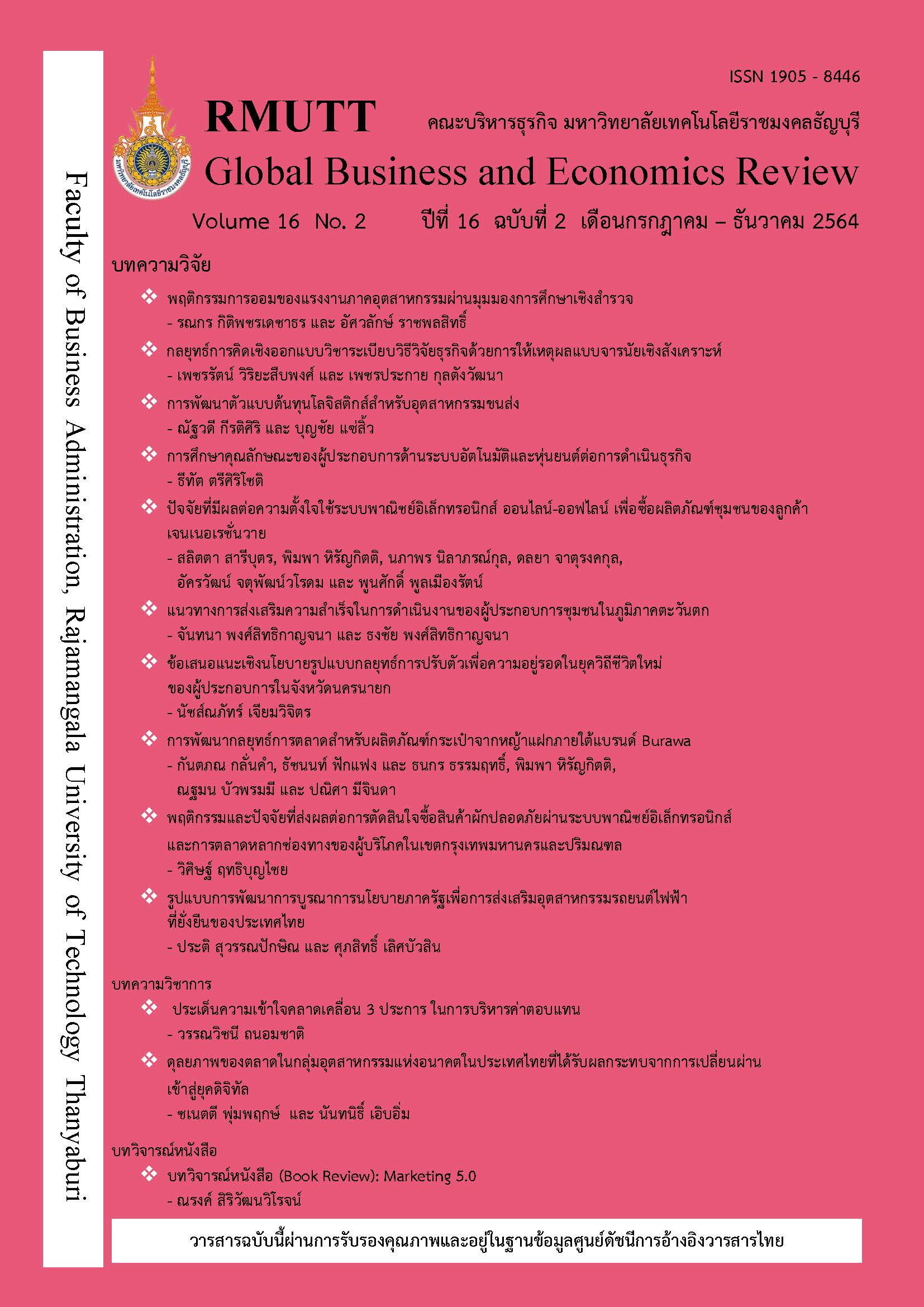ABDUCTIVE THINKING FOR DESIGN THINKING STRATEGIES IN BUSINESS RESEARCH METHODOLOGY
Keywords:
Abductive Thinking, Design Thinking, Business Research MethodologyAbstract
The purposes of this research were to conduct studies concerning the previous studies of students. Business Research Regulation Courses from 2013-2019. To develop design thinking skills and separate research data based by abductive learning for students Business Research Regulations. The population used in this research is the population at this time is the research work of students studying business research methodology from 2013-2019. The research instruments used are questionnaire, analysis and document research. Data analysis using the twin diamond model, there are 4 steps: Discover Define Develop and Deliver. The results of the research showed that the majority of documents evaluated were in good quality. There are 34 good quality researches from 56 research works, accounting for 61%. In summary, the evaluation results of first-level researchers and second-level researchers have a complete level of content that can be used for research development. The third level researcher develops design thinking skills in research design. In 2020 resulting in new problems resulting from the synthesis of research in 2 areas as follows: 1) guidelines for the development of personnel, economy and environmental resources of the community, and 2) the decision to buy coffee by consumers.
References
ดุษฎี โยเหลา และคณะ. (2557). การศึกษาการจัดการเรียนรู้แบบ PBL ที่ได้จากโครงการสร้างชุดความรู้เพื่อสร้างเสริมทักษะแห่งศตวรรษที่ 21 ของเด็กและเยาวชน: จากประสบการณ์ความสำเร็จของโรงเรียนไทย. กรุงเทพฯ: หจก. ทิพย์วิสุทธิ์.
ทศพร มะหะหมัด และ มนัส สุทธิการ. (2563). ปัญญาประดิษฐ์การจัดการทรัพยากรบุคคลสมัยใหม่ในองค์กร. RMUTT Global Business and Economics Review, 15(1), 75-89.
เพชรรัตน์ วิริยะสืบพงศ์. (2560). กลยุทธ์การเรียนรู้วิชาระเบียบวิธีวิจัยธุรกิจด้วยการวิจัยเชิงปฏิบัติการแบบมีส่วนร่วม. วารสารศรีปทุมปริทัศน์ ฉบับมนุษยศาสตร์และสังคมศาสตร์, 17(2), 101-108.
ไพศาล สุวรรณน้อย. (2558). การเรียนโดยใช้ปัญหาเป็นฐาน. สืบค้นจาก https://ph.kku.ac.th/thai/images/file/km/pbl-he-58-1.pdf
ลือชา ลดาชาติ. (2562). การให้เหตุผลแบบจารนัยของนักเรียนระดับชั้นมัธยมศึกษา: กรณีศึกษาเกี่ยวกับปัญหาหมอกควันในภาคเหนือ. วารสารปณิธาน วารสารวิชาการด้านปรัชญาและศาสนา, 15(1), 155-189.
วิจารณ์ พานิช. (2555). วิถีสร้างการเรียนรู้เพื่อศิษย์ในศตวรรษที่ ๒๑. สืบค้นจาก https://www.edulpru.com/eu/21st/st-006.pdf
วิจารณ์ พานิช. (2564). โรงเรียนเตรียมคน พร้อมสู้อนาคต. สืบค้นจาก https://www.gotoknow.org/posts/690900.
อนุชา โสมาบุตร. (2556). การจัดการเรียนรู้แบบใช้ปัญหาเป็นฐาน. สืบค้นจาก https://teacherweekly.wordpress.com/2013/09/25/problem-based-learning/
เอกวิทย์ มณีธร และ วีระยุทธ พรพจน์ธนมาศ. (2562). การแปรสภาพเป็นมหาวิทยาลัยในกำกับของรัฐในประเทศไทย สาเหตุ กระบวนการ ผลลัพธ์และปัจจัยที่เอื้อต่อความสำเร็จ. RMUTT Global Business and Economics Review, 14(1), 1-22.
Kenan Foundation Asia. (2551). การศึกษาไทย ร่วง 3 อันดับในปีนี้ จากการจัดอันดับโลกโดย IMD. สืบค้นจาก https://www.kenan-asia.org/th/thailandcompetitiveness/
The Standard. (2564). IMD ขยับความสามารถในการแข่งขันไทยปีนี้ขึ้นหนึ่งอันดับ อยู่ที่ 28 จาก 64 ประเทศ. สืบค้นจาก https://thestandard.co/imd-thailand-competitiveness/
Design Council. (2021). What is the framework for innovation? Design Council’s evolved Double Diamond. Retrieved from https://www.designcouncil.org.uk/news-opinion/what-framework-innovation-design-councils-evolved-double-diamond.
D.school. (2016). Welcome to the Virtual Crash Course in Design Thinking. Retrieved from http://dschool.stanford.edu/dgift/
Gibbons, S. (2016). Design Thinking 101. Retrieved from https://www.nngroup.com/articles/design-thinking/
Institute for Management Development (IMD). (2021). World Competitiveness Ranking. Retrieved from https://www.imd.org/centers/world-competitiveness-center/rankings/world-competitiveness/
Lu, S. C. Y., & Liu, A. (2012). Abductive reasoning for design synthesis. CIRP Annals – Manufacturing Technology, 61(1), 143-146.
Merriam-Webster. (2021). ‘Deduction’ vs. ‘Induction’ vs. ‘Abduction’. Learn the differences between these three types of reasoning. Retrieved from https://www.merriam-webster.com/words-at-play/deduction-vs-induction-vs-abduction.
Stefanou, C., & Salisbury-Glennon, J. D. (2002). Developing motivation and cognitive learning strategies through an undergraduate learning community. Learning Environments Research, 5(1), 77-97.
Walton, D. (2014). Abductive, presumptive and plausible arguments. Informal Logic, 21(2), 141-169.
Western Governors University. (2020). Teaching & Education What is cognitive learning?. Retrieved from https://www.wgu.edu/blog/what-is-cognitive-learning2003.html#close
Downloads
Published
How to Cite
Issue
Section
License
The articles published in this journal are the intellectual property of their respective authors.
The views and opinions expressed in each article are solely those of the individual authors and do not reflect the positions of Rajamangala University of Technology Thanyaburi or any of its faculty members. All components and content of each article are the sole responsibility of the respective authors. In the event of any errors, the authors shall bear full responsibility for their own work.








